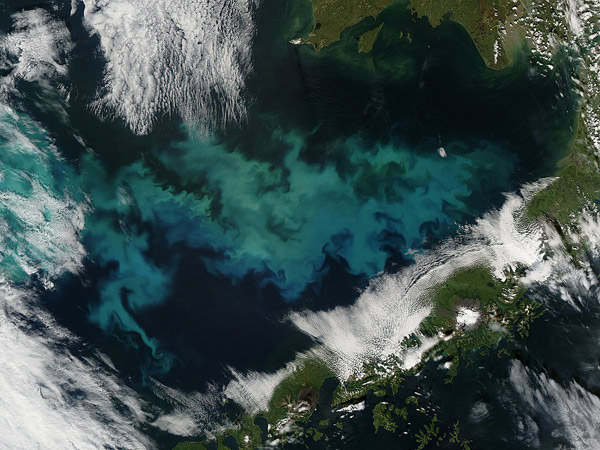Images
September 1, 2016 - Phytoplankon bloom in the Bering Sea
Tweet
Brilliant colors painted across the blue waters of the Bering Sea marked a dramatic phytoplankton bloom in late August 2016. The Moderate Resolution Imaging Spectroradiometer (MODIS) aboard NASA’s Aqua satellite captured this true-color image on August 28.
The multi-hued bloom floats in the waters west of the Alaskan Peninsula, while bright white clouds stretch over the Peninsula and part of the Bering Sea. The bloom is made up of massive amounts of tiny plant-like organisms known as phytoplankton. While phytoplankton exist in these waters year-round, it is only when conditions are just right that they begin to reproduce so dynamically that they created large blooms that are visible from space.
In the Bering Sea, blooms typically begin in the spring, when nutrients and water freshened from melting ice are more abundant near the ocean’s surface and when the increased sunshine and temperature of the lengthening days spur growth. After the spring bloom, phytoplankton populations usually plummet in summertime, after exhausting nutrients in surface water. By autumn, however, storms and cooler water allow nutrients to mix back to the surface, fueling more blooms.
Image Facts
Satellite:
Aqua
Date Acquired: 8/28/2016
Resolutions:
1km (72 KB), 500m (244.6 KB), 250m (576.8 KB)
Bands Used: 1,4,3
Image Credit:
Jeff Schmaltz, MODIS Land Rapid Response Team, NASA GSFC
Tweet
Brilliant colors painted across the blue waters of the Bering Sea marked a dramatic phytoplankton bloom in late August 2016. The Moderate Resolution Imaging Spectroradiometer (MODIS) aboard NASA’s Aqua satellite captured this true-color image on August 28.
The multi-hued bloom floats in the waters west of the Alaskan Peninsula, while bright white clouds stretch over the Peninsula and part of the Bering Sea. The bloom is made up of massive amounts of tiny plant-like organisms known as phytoplankton. While phytoplankton exist in these waters year-round, it is only when conditions are just right that they begin to reproduce so dynamically that they created large blooms that are visible from space.
In the Bering Sea, blooms typically begin in the spring, when nutrients and water freshened from melting ice are more abundant near the ocean’s surface and when the increased sunshine and temperature of the lengthening days spur growth. After the spring bloom, phytoplankton populations usually plummet in summertime, after exhausting nutrients in surface water. By autumn, however, storms and cooler water allow nutrients to mix back to the surface, fueling more blooms.
Image Facts
Satellite:
Aqua
Date Acquired: 8/28/2016
Resolutions:
1km (72 KB), 500m (244.6 KB), 250m (576.8 KB)
Bands Used: 1,4,3
Image Credit:
Jeff Schmaltz, MODIS Land Rapid Response Team, NASA GSFC




